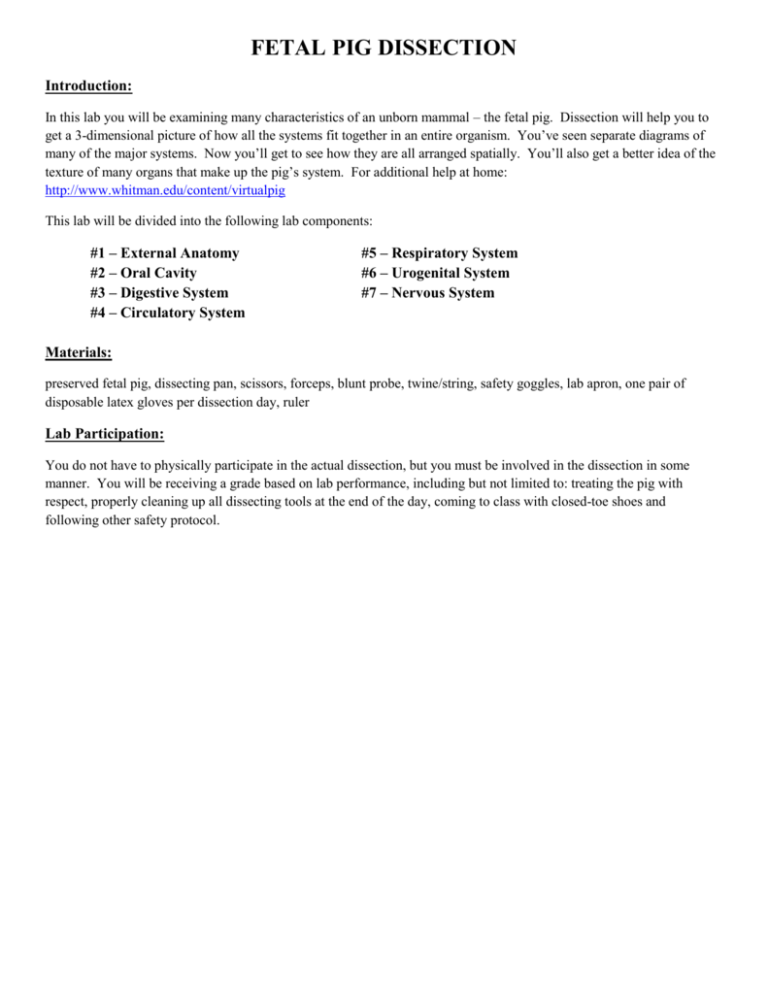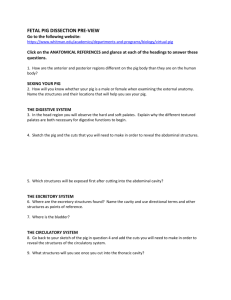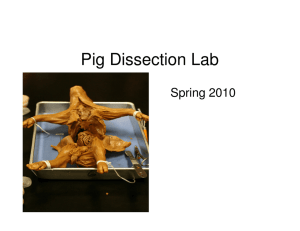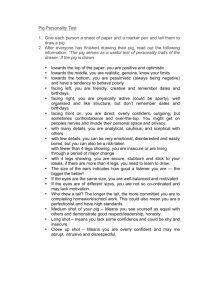Pig dissection - Ms.Feld's Science
advertisement

FETAL PIG DISSECTION Introduction: In this lab you will be examining many characteristics of an unborn mammal – the fetal pig. Dissection will help you to get a 3-dimensional picture of how all the systems fit together in an entire organism. You’ve seen separate diagrams of many of the major systems. Now you’ll get to see how they are all arranged spatially. You’ll also get a better idea of the texture of many organs that make up the pig’s system. For additional help at home: http://www.whitman.edu/content/virtualpig This lab will be divided into the following lab components: #1 – External Anatomy #2 – Oral Cavity #3 – Digestive System #4 – Circulatory System #5 – Respiratory System #6 – Urogenital System #7 – Nervous System Materials: preserved fetal pig, dissecting pan, scissors, forceps, blunt probe, twine/string, safety goggles, lab apron, one pair of disposable latex gloves per dissection day, ruler Lab Participation: You do not have to physically participate in the actual dissection, but you must be involved in the dissection in some manner. You will be receiving a grade based on lab performance, including but not limited to: treating the pig with respect, properly cleaning up all dissecting tools at the end of the day, coming to class with closed-toe shoes and following other safety protocol. Pig Lab #1 – External Anatomy 1. Obtain your pig and rinse it under running water. This will rinse off the excess preservative and will also get rid of the strong alcohol smell. Also be sure to rinse and dry the bag that your pig came in; we will use this to store your pig from day to day. 2. You will be examining several characteristics of an unborn mammal. Review the directional terms so you can communicate effectively with your classmates and teacher. Locate and identify the following regions of the body. cranial region cervical region thoracic region caudal region abdominal region 3. The period of gestation (the time of development inside the uterus) for the pig is 112-115 days. The age of the fetus can be estimated by measuring the body length from the tip of the snout to the attachment of the tail on the pig’s dorsal side. Compare this length to the data given on relative sizes of a fetal pig at different times during gestation. 21 days: 11 mm 35 days: 17 mm 49 days: 28 mm 56 days: 40 mm 100 days: 220 mm 115 days: 300 mm 4. Generally speaking, mammals are recognized and classified by their external appearance. The external features which separate mammals into orders include: the number of digits (toes or fingers) on the feet, method of walking or other locomotion, and characteristics of teeth. Count the number of digits present on your pig and record. 5. Examine the pig’s head. Locate the eyelids and the external ears (or pinna). The pinna helps the pig hear by focusing the sound into the middle ear. The eyes have an upper and lower lid and a small mass of tissue in the upper corner known as the nictitating membrane. This membrane helps keep the eye clean. Find the external nostrils. The lips around the mouth are well developed and the upper lip has a groove called the philtrum. Find this structure, and compare it to your indent. 6. Many mammals have sensory facial hairs called vibrissae; however, depending on the size of your pig you may not find these hairs yet. They help organisms feel their way around in the dark. Vibrissae of dogs and cats are commonly called whiskers. 7. Locate the umbilical cord. Which scissors, cut across the cord about 1 cm from the body. Examine the three openings in the umbilical cord. Observe that it contains three blood vessels: a large vein (blue; carries blood from the placenta to the fetus) and two smaller arteries (red; carry blood from the fetus to the placenta). 8. Observe the paired row of nipples on the ventral surface of the abdomen. The actual number of nipples varies from mammal to mammal. Animals that have litters tend to have more nipples. Count the number of nipples and record. 9. Determine the sex of your pig by locating the urogenital opening through which liquid wastes and reproductive cells pass. In the male, the opening is on the ventral surface of the pig just posterior to the umbilical cord. In the female, the opening is ventral to the anus. Record the sex of your pig. Pig Lab #2 – Oral Cavity Internal Anatomy – General Directions: In the dissection and observations of the internal organs, you will proceed by systems and remove organs only when directed to do so. As you dissect, keep in mind the interrelationships of systems. While concentrating on a single system, use care not to damage other systems. ALL cuts will be done with scissors. Dissection is an ART. You must carefully and accurately dissect your pig so you can identify important parts. Use caution when carrying and cleaning sharp dissection tools. 1. With a pair of scissors cut deeply into both corners of the mouth. This may be difficult as you must cut through both bone and tissue. Open the mouth. Be sure to follow the curvature of the throat and do not cut straight back into the neck tissue. 2. Examine the oral cavity containing the tongue and teeth. Notice the ridged roof of the mouth called the hard palate. The soft palate is the fleshy portion of the roof of the mouth and lies caudal to the hard palate. Run your finger from the teeth to the back of the throat and feel the difference between the two. 3. Locate the tongue with all its taste buds. Observe the different types of teeth. Canine teeth are longer for tearing food, while incisor teeth are shorter and are used for biting. Pigs have both types of teeth, which means that they eat both plants and animals. 4. Far back in the oral cavity is the pharynx, a common passage for food going to the esophagus and air going to the lungs. Locate the tear-shaped epiglottis, a flap like structure at the top of the trachea. Pig Lab #3 – Digestive System 1. Obtain two pieces of strong twine. Tie one piece around a wrist and one piece around an ankle. Pull each under the dissecting pan and tightly tie the twine to the opposite wrist or ankle. 2. Study the diagram below for the incisions you need to make. Be sure to keep the tips of your scissors pointed upward because a deep cut will destroy the organs below. Also, remember to cut away from yourself. 3. After you have made your incisions through the body wall, you will see the peritoneum, a thin layer of tissue that lines the body cavity. Cut through the peritoneum along the incision lines. 4. Spread the flaps of the body wall apart. Cut the umbilical vein which extends through the liver. 5. Once the vein is cut, carefully pin down the skin flaps to the dissecting tray using the provided pins. 6. The large, reddish-brown organ that occupies much of the abdominal cavity is the liver. Gently lift it up and probe it to locate the gall bladder, which is on the pig’s right side. 7. The diaphragm (a thin brown muscle tissue) is the tough muscle which separates the thoracic and abdominal cavities. The esophagus goes through it to the stomach. 8. Locate the stomach on the upper left side of the abdominal cavity. It is underneath the liver. The stomach resembles a pouch in appearance and is connected to the esophagus at its anterior end. Carefully remove the stomach being careful when separating it from other organs. Slit open the stomach longitudinally. Observe the pyloric sphincter and rugae. You may have to blot out the excess liquid to see these structures. 9. Locate the small intestine. The first 3-4 cm of the small intestine is the duodenum. The remaining length is divided into the ileum and jejunum. Observe that the small intestine is not loose in the abdominal cavity but is held in place by the mesentery. Check and look for veins and arteries in the clear mesentery that carry absorbed nutrients to the liver through the hepatic portal vein. Remove the small intestine. Carefully cut through the mesentery and uncoil the small intestine. Note and record its length in centimeters. 10. The large intestine appears as a compact coil and is larger in diameter than the small intestine. Locate the junction of the large and small intestine. Below this junction may be found a small pouch-like structure called the caecum. This is the same item that is the appendix in humans. It helps in the slow digestion of plant materials in other animals. 11. Follow the large intestine to the rectum. This lies in the dorsal wall of the abdominal cavity and is the straight end portion of the large intestine. Waste material stored in the rectum leaves the body through the anus. 12. Locate the pancreas which is a large white granular organ located below the stomach. The red elongated organ extending around the outer curvature of the stomach is the spleen, which resembles a tongue. Pig Lab #4 – Circulatory System 1. You will need to cut through the pig’s sternum and expose the chest cavity to view. See the diagram below to make the incisions. You will need to cut all the way up to into the pig’s neck, almost to the chin. Be careful in the neck area because most of the structures are very superficial. 2. The circulatory system of the pig consists of the heart, arteries, veins, and capillaries. There are two major parts to this system. Pulmonary circulation moves oxygen-poor blood to the lungs and returns oxygen-rich blood to the heart. The systemic circulatory system supplies all parts of the body with oxygen-rich blood via arteries and returns oxygen-poor blood to the heart via veins. 3. Locate the heart. Covering the heart is a thin, tough membrane called the pericardium. Carefully separate the pericardium surrounding the heart. 4. Locate the major vessels supplying blood to and from the heart. Locate the inferior and superior vena cava. These vessels should be blue. Locate the aorta, which should be red. 5. On the surface of the heart are the coronary arteries and veins. 6. Remove the heart by carefully cutting the arteries and veins leading to and from the heart as far away from the heart as possible. DO NOT damage any lung tissue. Cut the heart in half through the frontal plane using as few snips of your scissors as you can. Identify the right atrium, right ventricle, left atrium, and left ventricle. The structure between the two ventricles is the septum. Pig Lab #5 – Respiratory System 1. The respiratory system is responsible for the exchange of gases. The pig must take in oxygen to burn food and must rid itself of carbon dioxide once it’s born. 2. Locate the two, spongy lungs that surround the heart. The tissue that covers and protects the lungs is called pleura. The lungs haven’t been used by the fetus so they have never contained air. Count the number of lobes in each lung and record. 3. Find the trachea, a large air tube that lies anterior to the lungs. The trachea is easy to identify because of the cartilaginous rings that help keep it from collapsing as the animal inhales and exhales. 4. Notice that the trachea branches into each lung. These two tubes are called bronchiole tubes. Inside the lungs these branch into smaller bronchioles that end with a grape-like cluster of air sacs or alveoli where oxygen and carbon dioxide are exchanged with capillaries. 5. At the top, anterior end of the trachea, find the hard, light-colored larynx. This organ contains the vocal cords that enable the animal to produce sound. Pig Lab #6 – Urogenital System 1. Remove the digestive organs to study the excretory and reproductive organs that make up the urogenital system. 2. Locate the large, bean-shaped kidneys lying against the dorsal body wall. Notice that they are covered by the peritoneum. 3. Find the ureters, tubes which extend from the kidneys to the urinary bladder. The urinary bladder lies between the umbilical arteries and temporarily stores liquid wastes filtered from the blood. 4. Life the urinary bladder to find the urethra, the tube which carries urine out of the body. Follow the urethra to the urogenital opening on the outside of the pig’s body. 5. Follow the directions below for locating the excretory and reproductive organs in either a male or female pig. When you finish observing the organs in a pig of one sex, exchange specimens with another classmate to view the organs in a pig of the opposite sex. Male System 6. In the male pig, locate the two scrotal sacs at the posterior end of the pig. If the pig is in the later stages of development, you will find a testis in each sac. If the pig is in an early stage of development, the ovalshaped testes will be in the abdominal cavity. These testes have not yet descended into the scrotal sacs. 7. On each testis, find the coiled epididymis. Sperm cells produced in the testis pass through the epididymis and into a tube called the vas deferens. This tube crosses over a ureter and enters the urethra. 8. Follow the urethra to the penis, a muscular tube lying just below the skin posterior to the umbilical cord. Female System 9. In the female pig, find the two bean-shaped ovaries at the posterior end of the abdominal cavity. Observe the coiled Fallopian tube attached to each ovary, which carries eggs from the ovary. 10. Follow the Fallopian tube to the uterus. The uterus is dorsal to the urinary bladder and the urethra. 11. Trace the uterus to a muscular tube called the vagina. The vagina will appear as a continuation of the uterus. Sperm from the male are deposited into this organ during mating. The vagina and the urethra open into a common area called the urogenital sinus. This cavity opens to the outside at the urogenital opening. Pig Lab #7 – Nervous System 1. This dissection is difficult, tedious work and requires proceeding carefully to avoid destroying important brain tissues. Position the animal so that the dorsal side is up. Remove the skin from the entire skull. 2. In order to observe the brain, the skull bones (cranium) needs to be removed. Insert the point of your scissors just under the bone at the base of the skull. Angle the tip of the scissors upward so as not to damage the soft brain tissue. Cut forward along the midline to the eyes. Cut to either side at the point where you began cutting and the point where you stopped cutting. Gently remove the cranium by carefully using forceps to break and peel away the pieces. 3. The meninges are the membranes which cover the brain. You may have to snip and peel away the meninges to expose the brain. 4. The spinal cord helps transmit signals between the brain and afferent/efferent nerves. To expose the spinal cord, remove a 1 inch piece of the vertebral column. Inside the vertebral column you will see a fleshy, circular structure. This is the spinal cord. Name: ___________________________________________ Date: ______________ Period: _____ Fetal Pig Lab Analysis Questions Pig Lab #1 – External Anatomy 1. What is meant by gestation period? 2. What is the approximate age of your pig? 3. How many digits are present? 4. How does a fetus get rid of its waste products? 5. Name two external features that can be used to separate mammals into orders? 6. What goes in and out of the external nares? 7. What is another word for pinna? What is its function? 8. What is the function of the pig’s vibrissae? 9. What is the function of the pig’s nictitating membrane? 10. What is meant by urogenital opening? 11. Describe the major differences between a male and female pig’s urogenital opening(s). 12. What does the urethral opening excrete in males? Females? 13. What does the scrotum contain? 14. Label the diagram below with the following terms: cranial region, cervical region, thoracic region, caudal region, abdominal region, pinna, external nares, nictitating membrane, umbilical cord Pig Lab #2 – Oral Cavity 1. Why are the senses of taste and smell important to organisms? 2. How does the tongue aid in eating? 3. How are the hard and soft palate indirectly used in digestion? 4. What is the function of the epiglottis? 5. What substances are secreted by the oral cavity of humans that aid in digestion? 6. The esophageal opening is the top of which tube? Where does this tube lead? 7. Label the diagram below. Pig Lab #3 – Digestive System 1. Describe the intestinal mesentery. 2. In humans, what structure is found at the junction of the small and large intestine? 3. How many lobes (sections) does the liver have? 4. Where does the bile duct lead to and what substance does it carry? 5. What structure separates the thoracic cavity from the abdominal cavity? Spasms of this muscle causes what problem? 6. Describe the appearance of the inside of the stomach. How do the rugae within the stomach aid in mechanical digestion? 7. How can you tell where the small intestine stops and the large intestine begins? 8. What is an ulcer? 9. Label AND give the function of each of the following organs on the diagram below: stomach, esophagus, small intestine, large intestine, pancreas, liver, gall bladder Pig Lab #4 – Circulatory System 1. Which is larger, the left or right ventricle? Why? 2. Describe the differences between the right and left atria. 3. From what chamber does the pulmonary artery exit? 4. From what chamber does the aorta originate? 5. What is the importance of coronary circulation? 6. What is the function of heart valves? 7. Why is it so difficult to get to the heart during open heart surgery? 8. Using the following terms, explain in paragraph form the complete trip of a drop of blood through the heart and body. Start the trip in the right atrium. right atrium right ventricle left atrium left ventricle aorta pulmonary arteries pulmonary veins superior vena cava a.v. valve lungs Pig Lab #5 – Respiratory System 1. Explain, in paragraph form, the pathway of air from the outside of the body to the bloodstream. Be sure to use the following words: alveoli, bronchi, bronchioles, lung, mouth, nares, nasal cavity, trachea 2. Why is the trachea constructed with rings of cartilage? 3. How many lobes does the left lung have? The right lung? 4. Carbon dioxide is exhaled from the lungs. How is it produced? Pig Lab #6 – Urogenital System 1. How many kidneys does the pig have? 2. Where are the kidneys located? 3. In which of the female’s reproductive structures would embryonic or fetal pigs be found? 4. List a function for each of the following AND write whether each is a male or female structure. a. ovary b. testis c. uterus d. vagina e. epididymis f. urethra 5. Why is the scrotum important? 6. List a function for: a. ureter b. urinary bladder c. urethra Pig Lab #7 – Nervous System 1. What is the function of the cranium? 2. What divides the cerebrum into a right and left hemisphere? 3. What is the role of the cerebellum in the body? 4. List a function for each of the following: a. cerebrum b. cerebellum c. olfactory lobe d. medulla oblongata 5. When a person suffers from a stroke, what happens?





